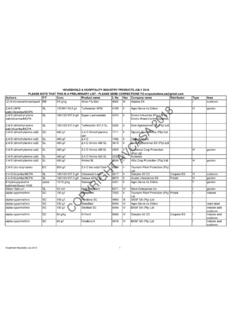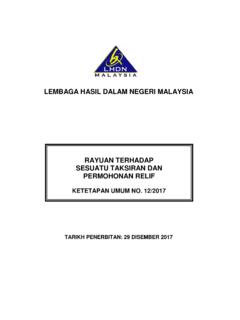Transcription of ADRENALINE (EPINEPHRINE) ANAESTHESIA TUTORIAL OF …
1 Sign up to receive ATOTW weekly - email ATOTW 226 ADRENALINE ( epinephrine ), 06/06/2011 Page 1 of 8 ADRENALINE ( epinephrine ) ANAESTHESIA TUTORIAL OF THE WEEK 226 6TH JUNE 2011 Prof. John Kinnear Southend University Hospital NHS Foundation Trust, UK Correspondence to QUESTIONS Before continuing, try to answer the following questions. The answers can be found at the end of the article, together with an explanation. 1. Which of the following statements concerning ADRENALINE is correct? a. It causes vasodilation when infiltrated into skin b. IV injection may cause arrhythmias c. It should be administered as 1 mg bolus IV injection for the treatment of acute asthma d.
2 It is metabolised by non-specific esterases in the blood 2. Name five different clinical applications for ADRENALINE . 3. Which of the following dosages are correct for ADRENALINE ? a. VF cardiac arrest 1 ml of 1:10 000 solution b. Anaphylaxis in a 5 year old child ml of 1:1000 solution IM injection c. Dilution with Bupivicaine for infiltration 1:200 000 d. Nebulised dose for a 2 year old with severe croup mg/kg e. IV dose for acute anaphylaxis 1 mg 4. The following are likely side effects of ADRENALINE injection (true or false?): a. Severe hypertension b. Maculopapular rash c. Bradycardia d. Tremor e. Bronchospasm INTRODUCTION ADRENALINE , also known as epinephrine , has rightly earned the title of the doctor s friend , since it is the drug that is turned to at times of greatest need, and this is particularly so in anaesthetic practice.
3 There are several clinical applications for ADRENALINE , most of them in situations where patients are acutely ill, and this requires all anaesthetists to be fully conversant with this essential drug. This TUTORIAL is presented in two sections. The first describes the clinical pharmacology of ADRENALINE , and the second looks at its use in clinical situations that are especially relevant to anaesthetists. CLINICAL PHARMACOLOGY Metabolism and Structure ADRENALINE is a naturally occurring catecholamine that is produced in the medulla of the adrenal glands, and acts as a hormone and neurotransmitter. All catecholamines are monoamines that are derived from the amino acids Sign up to receive ATOTW weekly - email ATOTW 226 ADRENALINE ( epinephrine ), 06/06/2011 Page 2 of 8 phenylalanine and tyrosine.
4 The series of metabolic reactions that occur in its synthesis are: oxidation of tyrosine to L-DOPA, decarboxylation to dopamine, oxidation to noradrenaline, and finally methylation to ADRENALINE (figure 1). ADRENALINE is broken down by monoamine oxidase (MAO) and catechol-O-methyltransferase (COMT), and may also be excreted unchanged by the kidney. The structure of the ADRENALINE molecule is given in figures 2 and 3. Figure 1. Metabolic pathway for synthesis of the catecholamines Sign up to receive ATOTW weekly - email ATOTW 226 ADRENALINE ( epinephrine ), 06/06/2011 Page 3 of 8 Figure 2.
5 2-dimensional structure of ADRENALINE Figure 3. 3-dimensional structure of ADRENALINE Presentation ADRENALINE is most frequently presented as a clear solution in a concentration of 1:1000 (1ml ampoule) or 1:10 000 (10 ml mini-jet for resuscitation). Both of these formulations contain 1 mg of ADRENALINE . It may also be formulated with local anaesthetic solutions for infiltration, most frequently in concentrations of 1:200 000, but may be as high as 1:80 000 (with Lignocaine 2% for dental injection). It can also be presented in Auto-injectors for use in anaphylaxis (see below) in doses of mg and mg (EpiPen ) for intramuscular injection.
6 Racemic ADRENALINE is a mixture of dextro (D)- and levo (L)-rotatory isomers of ADRENALINE , where it is the L- ADRENALINE which is the active form. Therefore the racemic mixture is less active and may have fewer cardiovascular side effects when nebulised. Sign up to receive ATOTW weekly - email ATOTW 226 ADRENALINE ( epinephrine ), 06/06/2011 Page 4 of 8 Pharmacodynamics ADRENALINE acts non-selectively at all the adrenergic receptors ( 1, 2, 1, 2, 3) to produce a flight or fight response. Its mechanism of action is via membrane receptors, which trigger a second messenger response as illustrated in figure 4.
7 Its main effects are summarised in Table 1. Figure 4. Receptors and 2nd messengers involved in ADRENALINE actions. Dose The dose and route of administration of ADRENALINE depends upon the clinical indication for which it is used, and will be more fully discussed in the next section. Side effects Side effects relate directly to the exaggerated effects of ADRENALINE , most commonly owing to overdosage, inadvertent intravascular injection, or inappropriate use. These include palpitations, tremor, light headedness, tachycardia, arrhythmias, hypertension, cerebral haemorrhage and acute pulmonary oedema. Biochemical abnormalities may include lactic acidosis.
8 Indications Clinical indications are discussed in the next section. Contra-indications There are no absolute contraindications to the use of ADRENALINE , but extreme caution should be shown whenever it is used owing to its profound effect on the cardiovascular system. Particular care must be taken when using it in patients suffering from arrhythmias, hypertension or ischaemic heart disease since these conditions may be acutely exacerbated. Caution should also be shown in patients taking monoamine oxidase inhibitors. Sign up to receive ATOTW weekly - email ATOTW 226 ADRENALINE ( epinephrine ), 06/06/2011 Page 5 of 8 Table 1.
9 Effects of ADRENALINE on organs and tissues in the body. CLINICAL APPLICATIONS The following conditions represent potential problems the anaesthetist may encounter in practice. Resuscitation ADRENALINE is the drug of choice for the treatment of cardiac arrest. Its main action is to increase vascular resistance via alpha-1 receptor vasoconstriction, which improves perfusion pressure to the myocardium and brain. Dose When treating VF/VT cardiac arrest, 1mg is given once chest compressions have restarted after the third shock and then every 3-5 minutes (alternate CPR cycles). For PEA arrest 1 mg is given as soon as intravascular access is achieved, and then every 3-5 minutes (alternate cycles).
10 ORGAN EFFECT RECEPTOR TYPE Heart Increase heart rate Increased contractility 1 1 Blood vessels Vasoconstriction Vasodilation 1 2 Lungs Bronchodilation 2 Metabolism Inhibits pancreatic insulin secretion Glycogenolysis in liver and muscle Glycolysis in muscle Gluconeogenesis Glucagon secretion in pancreas ACTH secretion by pituitary Lipolysis in adipose tissue Renin secretion from kidney 2, 2 1, 2 1, 2 1, 2 2 2, 3 1, 2 Uterus Relaxation 2 Sign up to receive ATOTW weekly - email ATOTW 226 ADRENALINE ( epinephrine ), 06/06/2011 Page 6 of 8 If the cardiac output is severely compromised but there is still a recordable blood pressure, smaller doses should be titrated to effect, using a concentration of 1:100 000.















